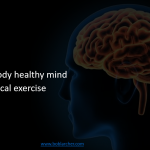Healthy body healthy mind – Part 3 Physical exercise

Most people are aware the physical benefits of exercise, but what about the mental benefits?
Mental Toughness isn’t about having big biceps, but physical exercise can help us to
- Release endorphins, helping us to feel happy and boost our mood
- Increase brain productivity, function and memory
- Help us relax, relieve stress and improve sleep
- Boost your immune system
- Have a profound positive impact on depression and alleviate anxiety
According to Mind, taking part in physical activity three times a week can also cut your chances of getting depression by about 20%
Physical exercise isn’t about running marathons or triathlons, it isn’t about “pumping iron” and it isn’t about doing push ups in the snow; neither is it about blocking a couple of hours once a week in the gym.
Physical exercise is, essentially, about sitting down less and moving our bodies more.
Sitting down for long periods is an easy trap to fall into, especially during the Covid crisis. Pre-crisis I spent most my time as a “stand-up” trainer, I would walk around, change locations, etc. – I now spend much of my time in front of my computer preparing and running webinars, and my walking is from one room to the next!
There are a lot of small things that can de done to increase physical activity
Go for an early morning walk; it doesn’t have to a long walk, maybe just five minutes to start with. A walk around the block or your housing estate will be enough to get the blood flowing through your veins; try increasing the time and distance each day by small increments every couple of days – you can always do 30 seconds more.
If you go to work by bus, get off the bus one stop earlier than normal and walk to work. If you drive to work, take the long walk to your office or place of work.
Don’t sit “hunched” in front of the computer or sit cross-legged for long periods; this constricts blood flow.
Take regular breaks and go for a short walk, outside preferably; breathe deeply and get that fresh air into the bottom of your lungs where the oxygen exchange is the most effective.
If you have to go to a meeting, leave slightly early and take the long route to the meeting room.
Leave time after eating lunch for a short walk, again five to ten minutes is sufficient to start with.
Increasing physical activity usually increases the desire to carry on Increasing physical activity; a kind of “virtuous cycle”
There are a lot of simple body movements that can be done at home to keep you physically fit; leg stretching, arm circles, sit-ups, press-ups, etc. None of these require any particular equipment and you can start slowly; three or four each day for the first week, then half-a-dozen or so for the second week, ten of each during the third week and before you know it you will be setting your targets high.
Make time for some slightly more engaging physical activities during your week; it doesn’t have to be hours every evening. Set aside a half-hour every few evenings for a longer walk (maybe a jog-trot-walk), a bike ride or a visit to the local swimming pool.
Regular physical exercise is much more accessible than most people think – go for it!